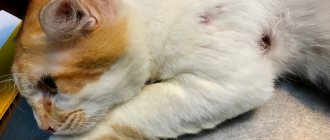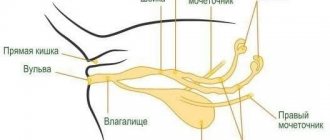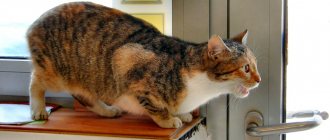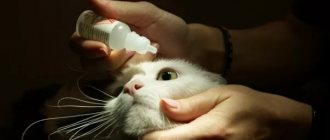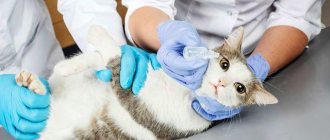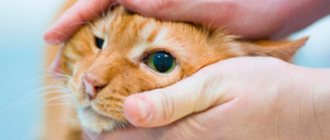Discharge from a cat's loop is a controversial phenomenon, since in some cases it can represent an absolutely normal condition, but in other situations it can be a serious signal of a problem with the pet's health. The most difficult thing in this matter is that it is quite difficult to distinguish abnormal discharge from normal discharge.
As a rule, discharge occurs normally in cats during pregnancy, the birth period, and also after it. Otherwise, if the cat is not pregnant, has not given birth or is breastfeeding, and has discharge, this is a reason to immediately consult a doctor, since the cause of such discharge can be serious illnesses, sometimes even leading to the death of the animal.
Cat has brown discharge
Vaginal discharge is any substance (such as blood, mucus, pus) that comes out of the vagina through the opening of the vulva.
Ideally, in a healthy cat, vaginal discharge is the result of a natural physiological process in which the secreted mucus lubricates the walls of the internal genital organs and protects them from infections. In the presence of pathology, the color, smell, quantity and consistency of the lubricant change, which allows timely detection of the problem before it worsens.
Free consultation Moscow
+7(495)162-70-70
In some cases, bloody and mucous discharge is normal, but in other cases it is a symptom of inflammation, infection, etc.
- Secretions consisting of serum and blood
Normal – during early estrus, “proestrus” stage; sometimes during “estrus” or in the “estrus” stage.
- Discharge containing blood, mucus and tissue debris (lochia) and other discharge
Normal – postpartum discharge for 6-8 weeks
- Discharge containing pus
Normal – at the beginning of “diestrus” there is a small amount of discharge
Unhealthy uterine discharge
Inflammatory diseases of the uterus lead to the accumulation of pathological substances in its cavity - waste products of bacteria, ichor, particles of epithelium, etc. Blood or pus from the vaginal opening may be a symptom of urogenital tract cancer. A cat suffers from discharge due to the following dangerous diseases:
Vaginitis
This is an inflammatory process in the vagina, which can be acute or chronic. Ulcers form on the surface of the mucous membrane, and the cat is bothered by discharge:
- cloudy or transparent;
- viscous yellow-white;
- mucous membranes are purulent.
Mild forms of the disease are treated with douching; in severe cases, systemic antibiotics are indicated.
© shutterstock
Pyometra
Life-threatening inflammation of the uterus, requiring urgent medical attention and surgical intervention. If a cat frequently licks itself, and brown wet spots remain everywhere on the bedding and carpets, then such symptoms should alert the owner. There are also other warning signs:
- tight or bloated belly;
- increased body temperature;
- lack of appetite, but strong thirst;
- frequent urination;
- decreased physical activity of the pet, lethargy.
In some cases, the cat's purulent discharge increases in quantity so quickly that the symptoms of the disease simply do not have time to appear. The walls of the uterus cannot withstand the load and rupture, and the contents spill into the abdominal cavity . Naturally, it is no longer possible to save the pet’s life.
Hematometer
The condition is characterized by the accumulation of blood in the uterine cavity, disrupting the functioning of the organ. Often blood cannot escape due to blockage or narrowing of the cervical canal, so the discharge from the cat's uterus is very scanty. The reason may be:
- congenital anomalies;
- muscle spasm of the cervical canal;
- surgical procedures performed incorrectly;
- miscarriage or abortion;
- pathological births (especially if they happen more than 1-2 times a year);
- uterine fibroids.
Blood is a rich nutrient medium for the proliferation of harmful microorganisms, which is why sooner or later inflammation of the uterus begins.
The cat has a fever and cramping pain appears. When helping an animal, clots must be scraped out of the uterine cavity and antibacterial therapy is prescribed. If hematometra is not diagnosed in time, purulent contents form in the uterus and the disease is complicated by pyometra. Fortunately, this disease is quite rare.
Endometritis
In a cat, discharge from the uterus may be a symptom of inflammation of the walls or mucous membranes of the organ. Acute endometritis occurs more often after childbirth due to delayed release of the placenta, infection of the vagina and cervix.
Mucopurulent discharge appears in cats from the genital slit 2–6 days after the birth of kittens.
Urination becomes more frequent, milk production decreases, and the temperature rises. The animal arches its back and meows pitifully due to pain in the uterus. In the absence of therapy, the pathology becomes chronic. The infection spreads to the muscular and outer layers of the uterus and penetrates the blood. As a result, the pet dies due to sepsis. Blockage of the cervical canal threatens the development of pyometra.
© shutterstock
Hydrometer
Fluid accumulates in the uterine cavity - gland secretion, mucus, transudate in quantities of up to 10 liters. If the excretory channel is open or partially blocked, then the cat experiences white or transparent discharge. Usually they are scanty, smearable or drop-shaped. The disease often develops against the background of chronic endometritis , as a result of which the uterine walls become thinner and stretched, adhesions and scars form. Without timely treatment, the cat dies.
Causes of discharge in cats
There are many risk factors that can lead to vaginal discharge:
- vaginal trauma;
- vaginal infection;
- urinary tract infection;
- abnormal cells in the vaginal area;
- preserved placenta after childbirth;
- death of the fetus in the womb;
- the presence of a foreign object in the vaginal cavity;
- estrogen medications prescribed during certain phases of the cat's estrus or estrous cycle; medications;
- certain antibiotics, which may cause vaginal discharge;
Since there are so many causes of this disease, it is recommended to consult a veterinarian if any type of discharge is detected.
Main symptoms of urethritis
The first signs of the disease are frequent and difficult urination.
The animal sits on the tray for a long time, trying to urinate. A little later, severe pain when urinating is added to these symptoms. Blood can often be seen in the urine, and purulent discharge from the urethra appears. The cat loses his appetite and starts drinking a lot. In this case, very little urine is released from the bladder. There is a sharp increase in temperature, fever, and aggressiveness. With urethritis, cats cannot go to the toilet and sit in the litter box for a long time.
If treatment is not started in time, then complete intoxication of the body occurs: the animal begins to salivate profusely, a sharp unpleasant odor of acetone appears, emanating from the skin, saliva and urine, photophobia, and weakness.
This condition is called the acute form of urethritis, and it is often accompanied by complete or partial blockage of the urethra. There is also a chronic course of the disease, in which the cat urinates without difficulty, but often and painfully, and completely cured urethritis appears again and again. As soon as the animal becomes hypothermic or catches a cold, all the symptoms of the disease return.
Diagnosis
If, when examining a sick cat, the veterinarian finds blood, pus, urine or feces in abnormal quantities, the veterinarian will need to review the cat's medical history and conduct a risk assessment.
A thorough medical examination of the cat is required to make an accurate diagnosis.
Call a veterinarian Moscow
+7(495)162-70-70
- Blood tests
- General urine analysis
- Vaginoscopy
- Vaginal cytology
- Biopsy
- X-ray
- Ultrasound
Discharge at different stages of pregnancy
The entire period of gestation of kittens is divided into 3 stages:
- 1–3 weeks – early,
- 4–6 weeks – fetal development,
- 7–9 weeks prenatal.
The most serious problems during pregnancy can appear in stages 1 and 3. And at the 2nd stage, only the growth of kittens in the mother’s womb occurs, and no important organs and systems are formed. During this period, no mucous secretions should appear in the pregnant cat. But there are situations in which discharge occurs and it is a variant of the norm, but this is rare. The problem is often that the animal licks itself frequently and well, so the owner may miss the appearance of discharge, especially white or yellow.
At the first stage, watery red discharge may be present, since at this time the embryo attaches to the uterus, and this causes injury to the mucous membrane. But at about 4 weeks, the uterus of a pregnant cat closes, and after this only light, colorless discharge is possible, which comes out along with the urine and is therefore practically invisible. These discharges may also have a yellow color, but not bright, but muted. Any other watery masses during this period signal problems with pregnancy.
At the 3rd stage, the body begins to prepare for childbirth. About a day before giving birth (but not earlier), noticeable mucous clots may appear. This is due to the rejection of the mucous membrane and indicates that everything will begin soon. Typically, in pregnant cats, mucous membrane rejection begins the moment the first kitten begins to move. Most often during this period, a pregnant cat has yellow discharge, less often - green. After active contractions, the color of the discharge turns from yellow to transparent, sometimes it contains splashes of blood.
Discharge is normal
Immediately after conception, the pet develops pink mucus. This is completely normal if mating occurs during estrus. You just need to pay attention to the intensity of such secretions; there should not be too much mucus. The smell and absence of blood are also important. There should not be a strong or unpleasant aroma. Otherwise, you should take your cat to a veterinarian to determine the cause of the problem.
Until approximately the 4th week of pregnancy, that is, until the uterus closes, unfertilized “extra” eggs may be present in the mucus. In cats, they appear as lumps that are a bit like leeches in appearance. You should not be afraid if such inclusions are present in your pregnant cat’s discharge. This process suggests that the flora in the cat’s uterus is sterilely clean, which means there are no inflammatory processes.
Prevention
In order for the process of bearing offspring in your animal to go smoothly, it is important to carry out preventive measures in a timely manner. Moreover, it is better to carry out some of them not at the moment when mating occurs, but throughout the entire life of the animal.
Monitor the animal’s health, get all the necessary vaccinations on time and select the right food, taking into account all the parameters. It would also be a good idea to have periodic checkups with a veterinarian.
After mating, you should carefully monitor the condition of the animal and pay attention to even the smallest changes.
- All the veterinarian's instructions must be followed very carefully.
- During pregnancy, you should protect your pet from cold, drafts and dampness.
- For mating, you should choose a healthy partner who has all the necessary vaccinations.
It is important that mucous discharge can also appear in a sterilized cat a short time after surgery. They have a slimy consistency and yellow color, but do not have a strong odor. If such discharge does not stop for a long time, then you should show your pet to a veterinarian, as inflammatory processes are likely to develop.
Proper care and following all doctor’s recommendations will help your cat have a normal pregnancy and give birth to healthy kittens. It is important for the owner only to pay attention to the condition of the pet, and everything else will happen by itself.
This article has been checked and approved by a veterinarian. Knyazeva Anna Vladimirovna, veterinarian in private practice, Moscow. more about the expert.
(you can vote for the article)
Tags: cat pregnancy, cat discharge, cat
- Related Posts
- A cat is dying: when should you put an old cat to sleep?
- How to get rid of cat smell in the house?
- Why might a cat's tooth fall out?
Pathological discharge
Even non-specialists understand that bloody watery masses are the most obvious sign of problems with pregnancy. The most dangerous is the light red mucus, which appears every 10–15 minutes, and more than 2 tablespoons comes out at a time. This is already a sign of internal bleeding, which requires surgical intervention. After all, most often such bleeding occurs when the uterus ruptures, which can even be fatal.
Brown or yellow discharge interspersed with blood at the 2nd stage of pregnancy indicates placental abruption or the death of embryos. It is necessary to contact a veterinarian because there are many different options in this situation. For example, if the placenta detaches at a fairly late stage, then the pregnant cat is prescribed additional diagnostics. These are various tests and ultrasound. In the absence of serious problems, constant monitoring is recommended, but, most likely, the pregnancy will end naturally.
If fetal death occurs, there are 3 main treatment options:
- causing premature birth,
- drug therapy,
- surgical intervention.
If a pregnant cat has yellow or green discharge with a strong and unpleasant odor, then one or more embryos have died. Mucus of this color appears when decomposition has already begun. In addition, yellow or green discharge may indicate intoxication in the animal’s internal organs and kidney failure. In these situations, urgent caesarean section or induction of labor is necessary. After this, the cat will have to go through a long period of rehabilitation.
The owner of the animal needs to be careful not to confuse diarrhea with yellow and brown discharge. But at the same time, you should not delay the treatment of such disorders of the digestive system, since in the future even the most minor diseases can affect the health of kittens.




